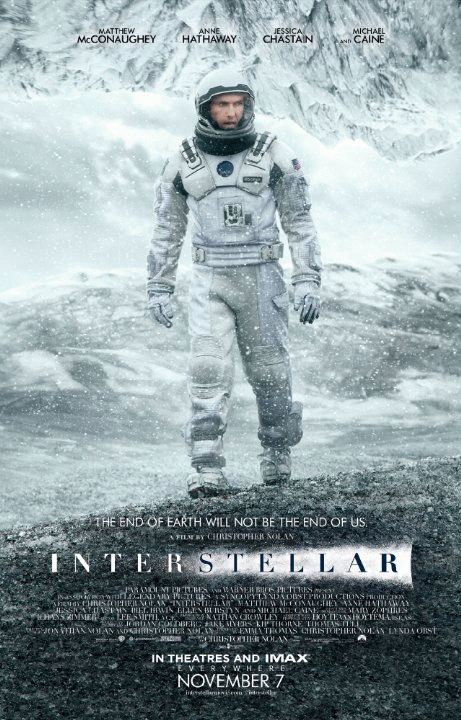'Humankind is either on its way to the stars or hurtling out of a high-rise window to the street and mumbling, "So far, so good."-(Why Things Bite Back-Edward Tenner.)
Christopher Nolan's slickly directed sci-fi film 'Interstellar' opens with the grim scenario of the earth being ravaged by blight which makes it unsustainable to support human life causing the advanced human civilization to regress to a failing agrarian model of development. But help is at hand with alien Intelligence directing the super hero Cooper -- a NASA pilot turned farmer- and his precocious daughter Murphy to a secret NASA installation run by the brilliant scientist Prof. Brand.
Prof Brand convinces the super hero Cooper -- imbued with a refreshing can do optimism and a heroic desire to explore uncharted frontiers of the outer space- to find another hospitable planet. In this noble quest aboard the NASA spacecraft Endurance, Copper is joined by Brand's daughter Amelia who is a biologist, physicist Romilly, geographer Doyle and two robots TARS and CASE in tow. The mission for this tech savvy team is to identify three promising planets orbiting the black hole Gargantua and locate the most hospitable planet with the right atmospheric conditions to sustain human life.
At one point it appears that Prof Brand could not solve the physics problem of evacuating the dying earthlings as he did not have an important input which lay buried in the black hole and that the best option available was to breed humans afresh on a new planet. But after a series of disasters and despair, arcane knowledge of space physics pays off.
Cooper and the surviving members of his crew obtain the critical input from the black hole which would enable the lifting of space station via gravity and convey the much needed information to Murphy who is now a NASA scientist. Murphy, much to the relief of the long suffering audience fed on adrenalin and popcorn, cracks the physics puzzle left unsolved by Prof Brand. The film ends on a happy note with the humans saved from extinction. Thanks to NASA and the daredevil Space Technology, 'the end of the earth will not be the end of us.' And while the vistas of limitless frontiers beckon us, there is a jubilant cry---We screwed the earth but now- by God's will -we have the whole fracking universe.
For much of the two odd hours of the film, the popcorn munching audiences seated in comfy cushioned sofas in the multiplex theaters get an exhilarating adventure of outer space. To the extent of providing escapism for the viewers trapped in humdrum lives, the film is a brilliant success. But as soon as the effects of junk snacks wear off and the critical faculties kick in -- the banality of the film becomes obvious. The message that the film conveys is a vapid rethreading of manifest destiny with the progress of expanding frontiers made possible by technological power for unlimited growth.
In a deeply philosophical and reflective book 'The Short History of Human Progress' Ronald Wright says civilizations collapse as they remain trapped in the 'assumption that a pattern of change exists in the history of mankind...that it consists of irreversible changes in one direction only, and that this direction is towards improvement.' As he points out 'Many of the great ruins that grace the deserts and jungles of the earth are monuments to progress traps, the headstones of civilizations which fell victim to their success. In the fates of such societies- once mighty, complex, and brilliant- lie the most instructive lessons".they are fallen airliners whose black boxes can tell us what went wrong.'[i]
(SOURCE:http://www.l-i-n-k-e-d.com/wp-content/uploads/2011/12/progress-trap.jpg)
And what do the black boxes tell us? Civilizations are invariably caught in progress traps which refers to the series of innovations whether in better hunting skills or better weaponry creating new problems for which society is either unwilling or unable to solve. In other cases the innovations may create conditions that are far worse than before the innovations were made.
Moreover, civilizations starting from the age of agriculture 10,000 years ago have indicated that human societies will move towards greater size and complexity making greater demands on earth's resources. Apart from the threat of resource depletion and hence unsustainability of civilizations, there is also problem of complex and technologically advanced societies becoming unstable and subject to rising costs and diminishing returns. [ii]
Modern technologically advanced civilization such as ours show signs of being failed civilization as it makes unreasonable demands on the natural environment to meet its obsessive high growth rates. To meet its energy requirements it relies on burning hydrocarbons and fossil fuels which increases climate instability. [iii]
We have not learnt the lesson that nature has its limits and those civilizations which live beyond the carrying capacity of their natural environment are doomed to fail. According to Neil Postman author of Technopoly, we live in a self justifying, self-perpetuating system wherein technology of every kind is cheerfully granted sovereignty over social institutions and national life which in itself is a progress trap from which there appears to be no escape.
In a sense Nolan's sci-fi film Interstellar depicting earth as becoming unsustainable for human life is uncomfortably close to reality but the tech fix solution of having a getaway space ship (courtesy NASA) to evacuate six billion people is infantile fantasy bordering on the absurd.
Perhaps, intelligent aliens visiting the doomed planet earth once teeming with people and surveying the vast wreckage of a spacecraft which was to evacuate six billion to safety, would shake their heads and be amazed at the foolishness of earthlings. How could they forget, they would wonder, the tragedy of Icarus who with wings made of feather and wax flew close to the sun and fell to his doom?
C R Sridhar
(Note: You can view every article as one long page if you sign up as an Advocate Member, or higher).








